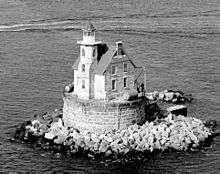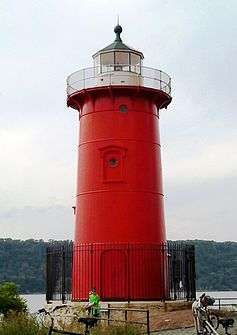Race Rock Light
 Race Rock light | |
 | |
| Location | Entrance to Long Island sound |
|---|---|
| Coordinates | 41°14′36.6″N 72°2′49.2″W / 41.243500°N 72.047000°WCoordinates: 41°14′36.6″N 72°2′49.2″W / 41.243500°N 72.047000°W |
| Year first constructed | 1878 |
| Year first lit | 1879 |
| Automated | 1978 |
| Deactivated | Active |
| Foundation | Granite and concrete caisson and pier. |
| Construction | Granite |
| Tower shape | Square/octagonal |
| Markings / pattern | Natural color with white lantern |
| Height | 45 feet (14 m) |
| Focal height | 67 feet (20 m) |
| Original lens | Forth order Fresnel lens |
| Range | 16 nautical miles (30 km; 18 mi) |
| Characteristic | Flashing Red 10s |
| Fog signal | Fog Horn points southeast. HORN: 2 every 30s |
| Admiralty number | J0686 |
| ARLHS number | USA-681 |
| USCG number | |
|
Race Rock Light Station | |
| Nearest city | Fishers Island, New York |
| Area | less than one acre |
| Architect | Francis Hopkinson Smith |
| Architectural style | Gothic Revival |
| MPS | Light Stations of the United States MPS |
| NRHP Reference # | [4] |
| Added to NRHP | April 29, 2005 |
Race Rock Light is a lighthouse on Race Rock Reef, southwest of Fishers Island, New York. The reef is a dangerous set of rocks off the coast of Fishers Island on Long Island Sound and was the site of many shipwrecks. It is currently owned and maintained by the New London Maritime Society as part of the National Historic Lighthouse Preservation Act program.[5]
Race Rock Light was built between 1871 and 1878. Designed by Francis Hopkinson Smith (1838–1915), the lighthouse is an excellent example of 19th century engineering and design. The massive masonry foundations on the reef required seven years to complete. Once the foundations were secure, the stone structure, including the keeper's quarters and the tower, were built in only nine months. The lighthouse has a fourth-order Fresnel lens in a tower standing 67 feet (20 m) above the waterline. The Coast Guard automated the light in 1978.[2]
The lighthouse is believed by some to be haunted. It was featured on an episode of Ghost Hunters[6][7] and seen in the show's opening credits.
History
Race Rock Lighthouse, in Long Island Sound, 8 miles (13 km) from New London, Connecticut, was built under great difficulties. The builder was Captain Scott. His engineer was F. Hopkinson Smith, who later became famous as a writer of lighthouse stories. Race Rock Lighthouse is off Fisher’s Island Sound, at the mouth of the Race, where the waters of the Sound rush both ways, according to the tide, with great velocity and force, and where, in heavy weather, the waves run high. By 1837 eight vessels had been lost in 8 years on Race Point reef.
In 1838 Congress appropriated $3,000 for erecting a lighthouse at Race Rock but the money was never expended. In 1852 the Lighthouse Board reported:
- "Various efforts have been made, and numerous appropriations expended, in endeavoring to place an efficient and permanent mark on this point. Buoys cannot be kept on it, and spindles have hitherto only remained until the breaking up of the ice in the spring." In 1853 $7,000 was appropriated "for a beacon on Race Rock." This took the form of a daybeacon completed in 1856.
In 1854 Congress appropriated $8,000 for a lighthouse but only $1,600 of this was spent, mostly in surveys. In 1869 $90,000 was appropriated "for a lighthouse at or near Race Point, Fisher’s Island, Long Island Sound." After preliminary surveys costing $652,857, an additional appropriation of $10,000 was made in 1870, after the Board had estimated that $200,000 would be required to build the lighthouse. In 1871 $150,000 more was provided by Congress.
Construction of the riprap foundation began in April 1871. In all 10,000 tons of granite were used in the foundation. "The proposals for the construction of the foundation and pier of this structure were so excessive in rates" the Board reported in 1872, "and so much above the amount of the appropriation on hand ($95,539.66 had been expended out of $261,000 appropriated to June 10, 1872) that no more than the landing and the enrockment of the foundation, and two courses of the pier, could be contracted for."
In 1873 Congress appropriated a further $75,000 and the lighthouse was completed at an additional expenditure of $175,048.09 between 1873 and 1878. The total cost of the lighthouse was $278,716.33.
The ledge on which the lighthouse is built is under water and three-fourths mile from Race Point Reef. It has one large and several smaller spurs of rock rising above the general surface. The least depth at mean low water on the principal spur or Race Rock proper, is 3 feet (0.91 m). The greatest depth at mean low water, within the circle of 69 feet (21 m), is 13 feet (4.0 m).
The ledge was, with the help of divers, made approximately level with small broken stone and riprap. Upon this was placed a circular-stepped mass of concrete, 9 feet (2.7 m) thick, built in 4 concentric layers. The lower layer is 69 feet (21 m) in diameter and 3 feet (0.91 m) thick. To form the layers of concrete, cylindrical bands of half inch iron, of the height and diameter required for the respective layers, were used. The upper surface of the concrete, 8 inches (200 mm) above mean low water, carries a conical pier, 30 feet (9.1 m) high, 57 feet (17 m) in diameter at the base, and crowned by a projecting coping 55 feet (17 m) in diameter. The pier is made of heavy masonry backed with concrete, in which cisterns and cellars are located.
The pier is surmounted by a 1 1⁄2 story granite dwelling. From the center of its front the granite light tower ascends. A landing-pier, 53 feet (16 m) long and 25 feet (7.6 m) wide, built of heavy masonry, gives access to the lighthouse. The whole structure is surrounded and protected by riprap. The tower, which is square at the base and octagonal at the top, carries a fourth-order alternating flash white and red electric light of 90,000 candlepower, being 67 feet (20 m) above sea level and 45 feet (14 m) above land, and visible 14 nautical miles (26 km; 16 mi) at sea.
It was added to the National Register of Historic Places in 2005 as Race Rock Light Station.[4]
In June 2011, the General Services Administration made the Race Rock Light (along with 11 others) available at no cost to public organizations willing to preserve them [8][9] as part of the National Historic Lighthouse Preservation Act program. The New London Maritime society took ownership of Race Rock Light as well as two lighthouses that mark the approach to New London, Connecticut [5]
References
- ↑ Light List, Volume I, Atlantic Coast, St. Croix River, Maine to Shrewsbury River, New Jersey (PDF). Light List. United States Coast Guard. 2009. p. 181.
- 1 2 "Historic Light Station Information and Photography: New York". United States Coast Guard Historian's Office.
- ↑ Rowlett, Russ (2010-04-08). "Lighthouses of the United States: Downstate New York". The Lighthouse Directory. University of North Carolina at Chapel Hill.
- 1 2 National Park Service (2009-03-13). "National Register Information System". National Register of Historic Places. National Park Service.
- 1 2 http://www.theday.com/local/20150806/new-london-maritime-society-takes-over-as-new-london-ledge-light-owner
- ↑ "Ghost Hunters". SciFi Channel. Season 1. Episode 104. 2004-10-27.
- ↑ Hawes, Jason; Wilson, Grant; Friedman, Michael Jan (2007). "The Bet July 2004". Ghost Hunting: True Stories of Unexplained Phenomena from The Atlantic Paranormal Society. New York: Pocket Books. pp. 92–98. ISBN 978-1-4165-4113-4. LCCN 2007016062.
- ↑ "For sale: Waterfront property; cozy, great views, plenty of light, needs TLC". CNN. Retrieved 12 July 2011.
- ↑ Beatty, MaryAnne. "GSA Making 12 Historic Lighthouses Available at No Cost to Public Organizations Willing to Preserve Them". GSA Website. US General Services Administration. Retrieved 12 July 2011.


